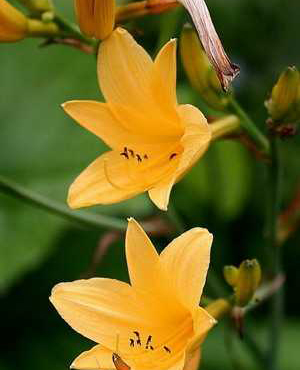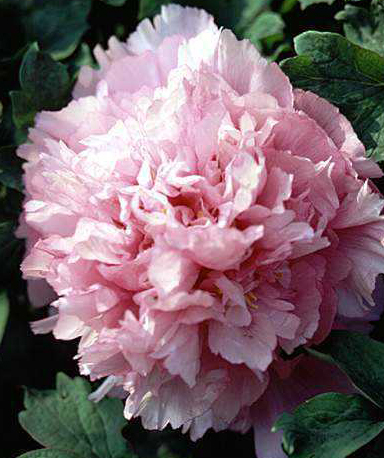How to water and fertilize the peony
Peony likes moderate wet tide, afraid of waterlogging, plus fleshy roots, so it is not suitable to water too much, especially afraid of ponding, otherwise easy to rot roots and leaves. Watering should be less after germination in early spring, and timely watering should be paid attention to when it is dry in spring; summer weather is hot, evaporation is large, and watering needs more. But not more watering in rainy season, autumn watering should also be appropriate, otherwise affect the flowering of the coming year.
Timely fertilization is an important measure to make peony flowers big and colorful. Fertilization should not be applied to newly planted peonies until half a year later. From the beginning of the second year, when the leaves and buds are extended, the fertilizer is applied to promote the flowering of peony in the same year, which is called flower promotion fertilizer. The second fertilizer within half a month after flowering has great influence on restoring plant growth and promoting flower bud differentiation, thus determining the number of flowering in the second year, which is called bud promotion fertilizer. Applying fertilizer for the third time in autumn and winter plays an important role in increasing the growth in spring next year. Fertilizer is applied three times a year, the first to the third time, the fertilizer is mainly available, and the fertilizer for the third time is mainly base fertilizer.

watering
Spring temperature rises quickly, but there is still cold wave attack, early spring irrigation is necessary; can effectively reduce the ground temperature, delay plant germination, avoid peony suffer late frost and late spring cold harm. If watering too late, not only can not play the role of cold, antifreeze, but also affect the quality of flowering. Therefore, spring irrigation should be early rather than late, in early spring irrigation is the most appropriate, at this time watering should also be based on the principle of seeing dry and wet, irrigation must be transparent, to the soil surface no ponding is appropriate, not too wet. However, peony flowering should be controlled watering, watering too much will shorten the flowering period, so that flowers wither prematurely.
trimmer
Peony often sprouts a large number of bottom buds at the base in spring, and timely pruning is very important. There are three main aspects to pruning peony: one is to pedicure peony. Except for the branches used for updating or correcting crown shape, the rest of the new soil buds should be cut off to avoid consuming a lot of nutrients for their growth, affecting the quality of flowering and flower bud differentiation in summer. The second is to remove too many buds. In line with the principle of leaving strong buds to weak, each branch can only retain a robust bud. The third is to cut off the remaining flowers of the plants that are not intended to be planted to prevent the consumption of large amounts of nutrients due to their fruiting.
fertilizer application
Peony spring fertilizer is generally applied twice, that is, early spring fertilizer and midspring fertilizer after flowering. The first time is pre-flowering fertilizer, that is, flower promotion fertilizer, which should be carried out in early March. This fertilization greatly promoted the flowering and color of peony in that year; the second fertilization should be carried out within half a month after peony flowering. This fertilization can promote plant growth and flower bud differentiation, and has a direct impact on the number and quality of flowering in the second year. In daily management, people often neglect post-flowering fertilizer. In fact, this fertilization is very important. Therefore, in general, within half a month after flowering, phosphorus and potassium-based compound fertilizer is applied once, and some decomposed and fermented manure can also be applied appropriately. If the plants grow poorly after flowering, 0.2% potassium dihydrogen phosphate solution can also be used for foliar topdressing to promote the flourishing of plants.
shade
After flowering, shade properly. Although peony likes light but avoid exposure, flowers bloom in weak shade under the best growth. Peony is in full bloom in early May. If it is not properly shaded and the temperature is too high, it will not only shorten its flowering period, but also easily make the blooming flowers lose luster and reduce the ornamental value. Therefore, appropriate shade measures should be taken during peony flowering to allow it to receive light before 9 a.m. and after 5 p.m. This can make peony flower big color fresh, flowering period prolonged, but also can effectively avoid leaves by sunlight sunburn, appear scorched edge phenomenon.
pest control
Although spring is not the high incidence period of peony diseases and insect pests, if the control work is relaxed, it is easy to make the plant suffer from diseases and insect pests during the growth period, or even the whole plant dies. Therefore, it is advisable to spray 3 ~ 5 Baume degree of sulfur mixture on plants once before leaf opening in early spring, spray 1000 times of 50% thiophanate-methyl wettable granules every 15 days after flowering, or alternatively use 800 times of 50% carbendazim wettable granules to effectively control fungal diseases such as black spot, stem rot and leaf blight. Peony is vulnerable to aphid harm in spring, if there is available omethoate and other broad-spectrum pesticides to kill.
Flowering management precautions
Sufficient light is very beneficial to the growth of peony flowers, but it should not be exposed to the sun for a long time. The suitable temperature for growth is 25~25℃, and the plants dormancy above 25℃. During the period before flowering, the plants should be ventilated in time to avoid excessive temperature and affect the growth of the plants.
Peony characteristics are "four should be afraid of", that is, should be cold afraid of cold, should be warm afraid of heat, should be afraid of shade, should be dry afraid of wet. Therefore, planting peony should choose spacious and ventilated, sunny in the morning, fertile and loose soil, not planted in ponding land, damp land or rubble land.
Peony planting is different from other flowers. Peony planting does not need irrigation, let alone manure irrigation. People can block the soil in winter to prevent cold, and open the blocked soil after warm spring to facilitate growth.
Peony winter to cover grass frost, March warm weather should be removed cover grass.
Chinese peony has extensive ecological adaptability, so it is easy to cultivate and simple to manage. Friends who like peony flowers should plant them quickly.
- Prev

What are the common cultivated varieties of Hemerocallis
Day lilies are called cauliflower. The flower color is yellowish to orange, in the form of a wide funnel, flowering from May to September. At present, the widely cultivated are: 1. Hemerocallis. Panicle-shaped Cymes, each with 6-12 flowers, flowers 7-11 cm long, petals wrinkled at the edge, orange to orange, with reddish-brown spots at the bottom of the lobes
- Next

The difference between Peony and Paeonia lactiflora
The biggest difference between peony and Paeonia lactiflora lies in: 1. Peony is shrub, the stem is oyster, except the annual branch is green, the other branches are brown, while Paeonia lactiflora is perennial herb, the stem is herbaceous, green, and all the aboveground parts wither in winter. 2. The leaf type of peony is pinnately compound leaf.
Related
- Fuxing push coffee new agricultural production and marketing class: lack of small-scale processing plants
- Jujube rice field leisure farm deep ploughing Yilan for five years to create a space for organic food and play
- Nongyu Farm-A trial of organic papaya for brave women with advanced technology
- Four points for attention in the prevention and control of diseases and insect pests of edible fungi
- How to add nutrient solution to Edible Fungi
- Is there any good way to control edible fungus mites?
- Open Inoculation Technology of Edible Fungi
- Is there any clever way to use fertilizer for edible fungus in winter?
- What agents are used to kill the pathogens of edible fungi in the mushroom shed?
- Rapid drying of Edible Fungi

